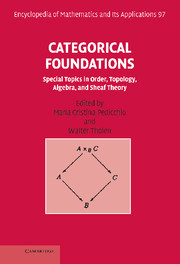Book contents
- Frontmatter
- Summary of Contents
- Preface
- Contents
- Introduction
- I Ordered Sets via Adjunction
- II Locales
- III A Functional Approach to General Topology
- IV Regular, Protomodular, and Abelian Categories
- V Aspects of Monads
- VI Algebraic Categories
- VII Sheaf Theory
- VIII Beyond Barr Exactness: Effective Descent Morphisms
- Index
VI - Algebraic Categories
Published online by Cambridge University Press: 05 November 2013
- Frontmatter
- Summary of Contents
- Preface
- Contents
- Introduction
- I Ordered Sets via Adjunction
- II Locales
- III A Functional Approach to General Topology
- IV Regular, Protomodular, and Abelian Categories
- V Aspects of Monads
- VI Algebraic Categories
- VII Sheaf Theory
- VIII Beyond Barr Exactness: Effective Descent Morphisms
- Index
Summary
Introduction
The aim of this note is to make the reader familiar with the notion of algebraic category.
The approach we use is based on Lawvere's pioneering work [20], where the notions of algebraic theory and algebraic category are introduced as invariant formulations of Birkhoff's universal algebra. The new and innovative idea is that an algebraic theory is a definite mathematical object (“the perfect idea of – for example – a group”), namely a small category with finite products; an algebra or model is a finite-product-preserving functor (“a possible meaning”) from such a category to the category of sets. Hence an algebraic category will be the category Modj- of finite-product-preserving functors on a small category Twith finite products. To make things simpler we will start with one-sorted algebraic categories, i.e. with models of the form F: T → Set where T is a category having as objects a set {T0, T, T2, …, Tn, …} of finite products of a single object T; then we move to the general multi-sorted case.
The beauty of the subject comes from the interplay between properties of the theory (the description, the syntax) and properties of the objects described (the models or semantics).
In Section 1 we present these basic notions and prove the main properties of algebraic categories. One novelty in our approach in comparison to classical treatments on the subject (see for example [6]), is the use of reflexive graphs and of their co-equalizers.
- Type
- Chapter
- Information
- Categorical FoundationsSpecial Topics in Order, Topology, Algebra, and Sheaf Theory, pp. 269 - 310Publisher: Cambridge University PressPrint publication year: 2003



